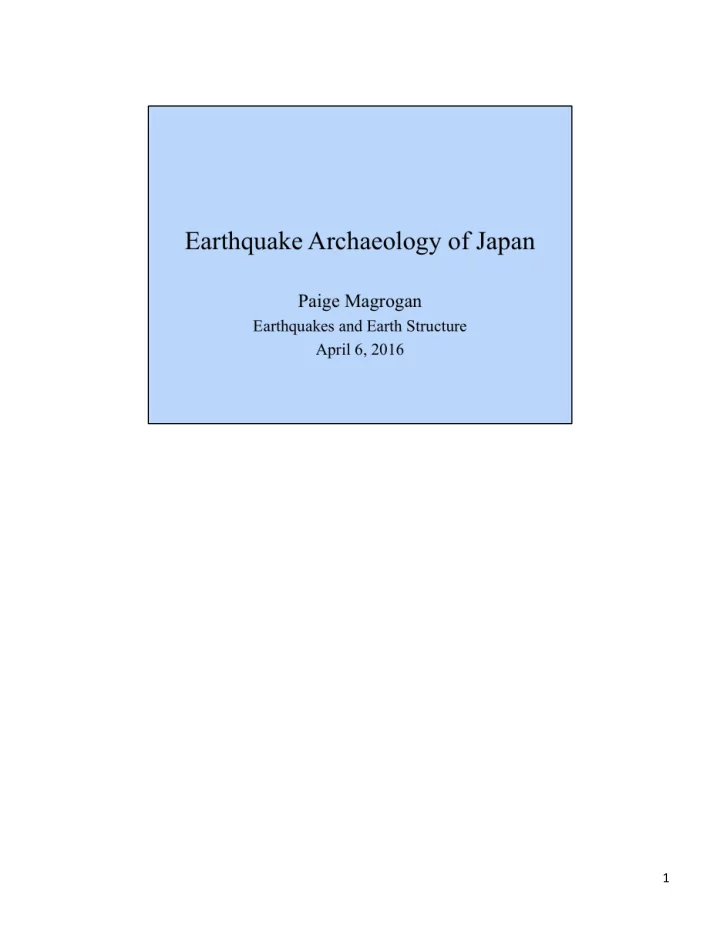

1
Also known as archaeoseismology, but more o7en called earthquake archaeology in Japan. 2
Usually pre-instrument or prehistoric earthquakes. More geological, less anthropocentric focus. Fault idenCficaCon methods: slip measurement, tectonic deformaCon. I’ll explain sediment liquefacCon evidence in a few minutes, because it is parCcularly favored by Japanese researchers. Faults are not always visible even a7er trench excavaCons. Also menCon limitaCons of absolute daCng. Lots of interpretaCon. Paleoseismological methods may only detect strong, destrucCve events. Secondary effects are used to infer that an earthquake took place, but no direct evidence. 3
Sources of data include individual accounts, archives, early scienCfic records. “Size” because magnitude very hard to determine. Intensity also depends on quality of the records. Lack of communicaCon between disciplines a recurring theme. Central problem is you are constrained by the records that exist. Many places, like the Mediterrranean, China, and Japan have abundant records, but not always very detailed. Some socieCes made records we don’t know how to read. Effects on the environment ambiguous. Epicenter? Intensity? Nearly impossible. 4
SomeCmes excavaCons/survey used as confirmaCon for historical records, but historical records used for daCng when absolute radiometric dates are unavailable. Mapping is also a huge issue. You don’t know that a person who records an event was near the epicenter. PreservaCon bias toward catastrophic events. 5
But, it is important to keep in mind that Japanese researchers much prefer paleoseismological methods, especially idenCfying liquefacCon, since buildings tend to be made of organic materials. NoCce the preservaCon bias toward catastrophic events – events that people could recover from may not be preserved archaeologically, because they would just rebuild. Plus, keep in mind that none of these is inherently indicaCve of an earthquake alone. And noCce the bias to the Mediterranean context – columns, arches. The theory being that if columns fall or arches bend in uniform ways at a site, it was caused by seismic waves and not human intervenCon. MenCon Neanderthal vigne^e in Shanidar Cave if Cme allows. Keeping in mind that many things crush skeletons. 6
Interest in collaCng chronicles of earthquakes began during the Meiji RestoraCon. Also, archaeology and history (and geology) are very closely allied in Japan, in a way not seen in North America. The first documented earthquake was 599 CE in the Nihon Shok, and there are hundreds a7er. The 1995 earthquake brought about the Disaster Concerned Archaeologists’ Network. Goals of the symposia were risk assessment and to be^er understand the past. They had their work cut out for them! MeeCngs with more than 100 archaeologists revealed that there were apparently 378 sites throughout Japan with earthquake damage as of the 1990s. 7
Though Kofun period tombs (first historic period in Japan) show displacement consistent with faulCng because they’re made of stone. Chinese-style buildings are flexible because of the way each horizontal piece of wood is a^ached to corner posts (sturdy but flexible), and they stone foundaCons, allowing the building to shake separately and have a stable plalorm to come to rest on. Skyscrapers built in the 1960s and later based on this building style. Po^ery and stone tools in Japan have the most robust classificatory system in the world. 5-year periods is amazing. 20-year periods for some items though. Depends on the type of material. 8
Widespread correlaCon over many sites from the same Cme period, to see whether the same type of deformaCon is noCced. Not to menCon making sure something else besides an earthquake didn’t cause the deformaCon. This method of research looks promising, but more refined chronologies are needed, including Stone Age sites. 9
This happens when sediment is deposited under an impermeable layer like clay, and water is trapped inside the sand layer. Shaking causes the water to expand, building up pressure and causing the sand to erupt and form these characterisCc sediment dikes. LiquefacCon characterisCc of earthquakes. Apparently very common in Japan. Frequently seen during excavaCons. 10
11
A^enCon of archaeologists shi7ed to preservaCon issues because the tsunami and nuclear fallout destroyed a lot of stuff. It is uknown if arCfacts around the nuclear plant site will ever be retrievable. Because so much context and informaCon is now lost. A debate surrounding the tension between the government’s desire to move people and archaeologists’ desire to save sites ensued. Government sided with archaeologists. Lots of rescue work ensued. Problems: lack of staff, may delay fieldwork and publicaCon. Somewhat surprisingly, the public has largely agreed with this – knowledge of the past considered too important to be destroyed. 12
Of course, the economy is worse now – not enough archaeologists, which will make these goals more difficult to achieve. There has been a proliferaCon of the use of social media by archaeologists, as well as an effort to make one GIS system for all earthquake archaeology in Japan. CollaboraCon between archaeologists, people of other disciplines, and the public. Giving people hope: Japanese people in the past experienced devastaCng earthquakes, and they were able to pick themselves up and move on. So we must not despair. We can move on too. 13
14
15
Recommend
More recommend